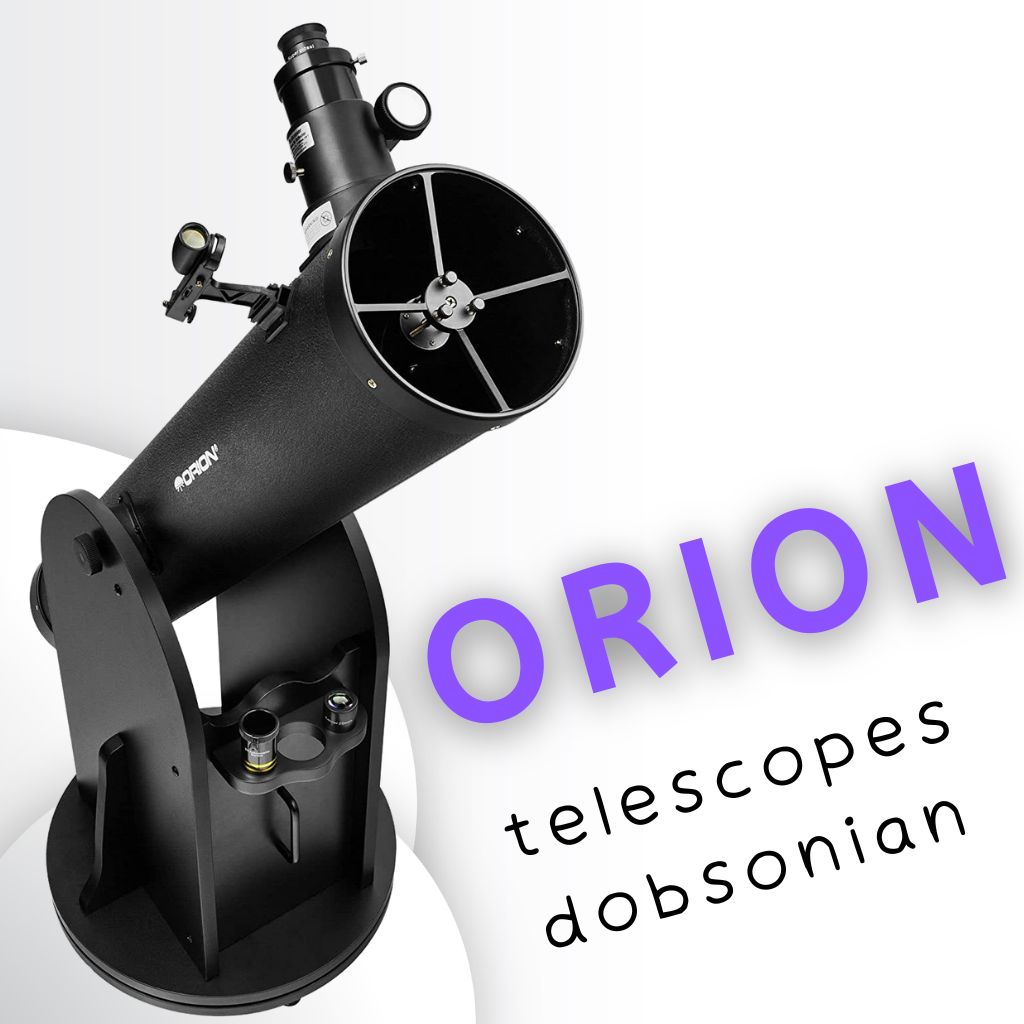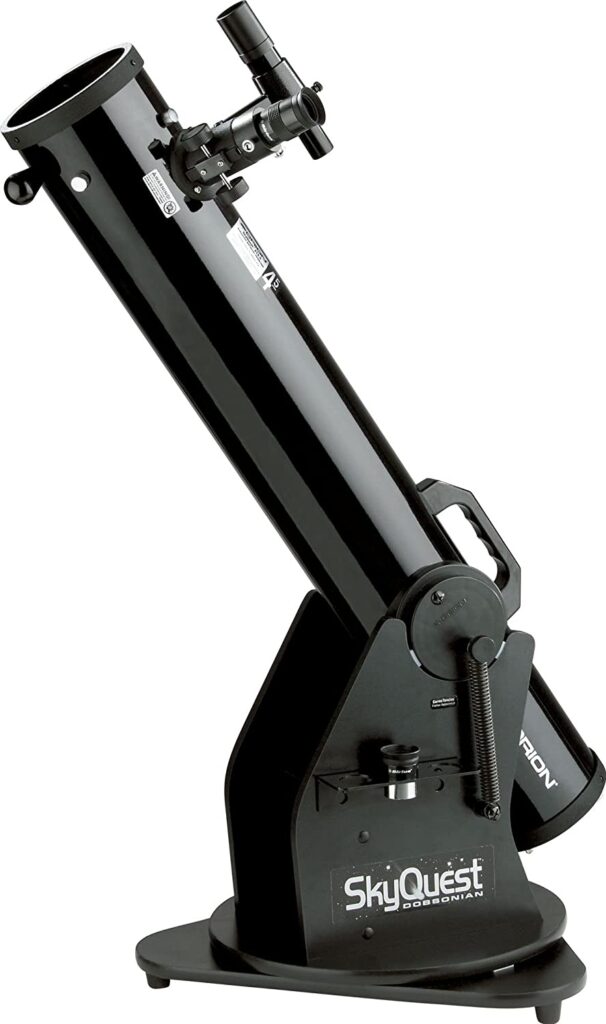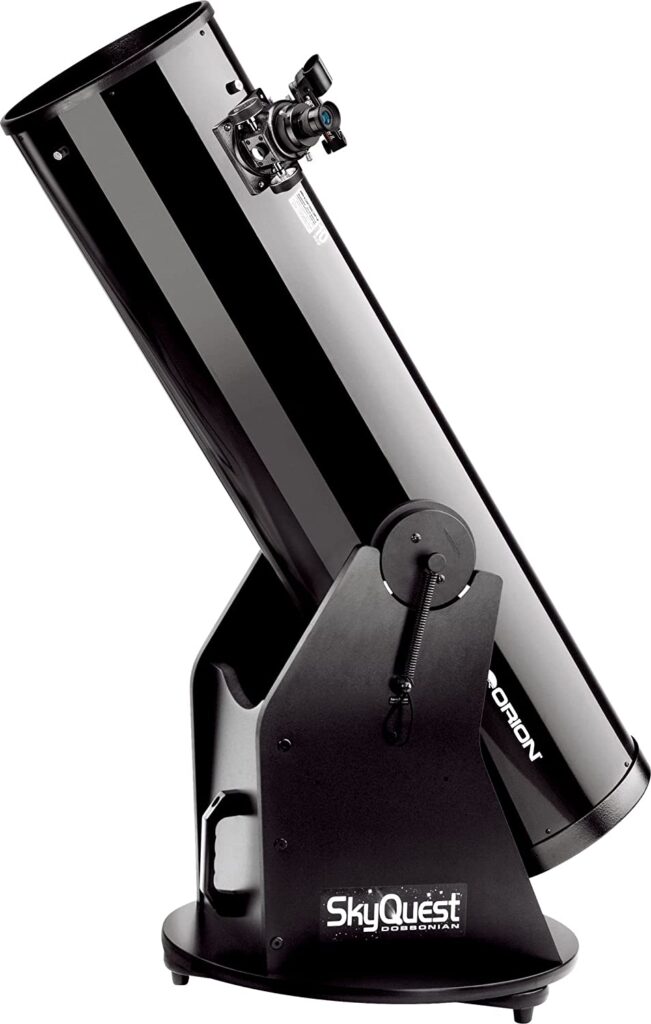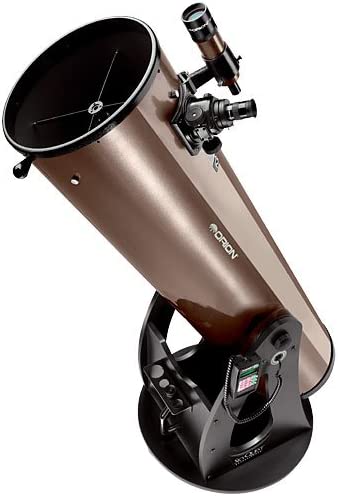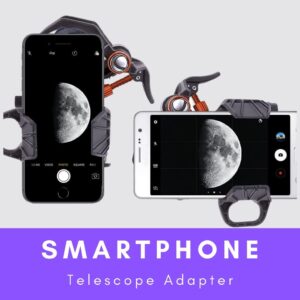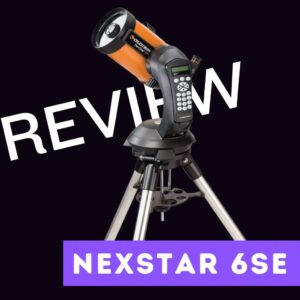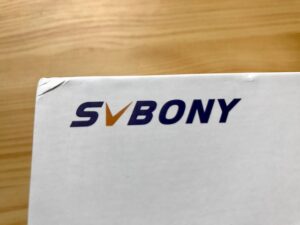This site contains affiliate links to products. I may receive a commission for purchases made through these links.
Orion Telescopes remains one of the most reputable telescope brands today. They are a brand that has combined longevity with expertise to provide customers with quality products of the highest value. One of those products is their Dobsonian telescopes, which have multiple models.
Orion Dobsonian telescope models include Orion SkyQuest Classics 4.5, 6, 8, 10, Orion Dobsonian XT8i motorized telescope, Orion SkyQuest XT12, Orion SkyQuest IntelliScope 8”, 10”, 12”, Orion SkyQuest XX12g, XX14g, and Orion monster Dobsonian telescope.
This article offers a comparative analysis of all Orion Dobsonian telescopes. You’ll find here important details about what makes each of them suitable for different levels of astronomy.
Orion SkyQuest Classic 4.5 telescope for amateur astronomy
The Orion SkyQuest Classic 4.5 is the smallest of the brand’s Dobsonian classics. It is a brilliant entry-level telescope that’s most suitable for amateur astronomers.
With its unique size, 17.6 lbs weight, and compact frame, users can take it wherever they want for night sky observation. This Orion SkyQuest model is notable for its 4.5″ aperture that collects enough light to give users quality 6×26 imaging of celestial objects targeted during night sky observation.
The telescope’s focal length is relatively long but sufficient for a great view of star clusters and planets like Saturn, Moon, and Jupiter. As an individual with a budding interest in astronomy, the Orion SkyQuest Classic 4.5 is a good choice.
So if you want to enjoy the fun of stargazing, you should get the Orion SkyQuest Classic 4.5 telescope.
Orion SkyQuest Classic 6 telescope for beginners
The Orion SkyQuest Classic 6 is another amazing option for rookie astrophiles, particularly those on a budget. It offers a fantastic view of a target object in its brightest, sharpest, and most apparent forms.
The popularity of the Orion SkyQuest Classic 6 among beginner astronomers is an indication of its efficiency. It’s a better upgrade than the 4.5-inch predecessor because of its excellent light grasp and magnifying capacity.
With its 1200mm focal length, you can enjoy unimaginable access to limitless possibilities in space observation under the night sky. In addition to all these, the telescope comes with an array of accessories that enhance your stargazing experience.
These accessories include Orion MoonMap 260, DeepMap 600, and an adjustable smartphone adapter for taking pictures through the telescope’s eyepiece. These, amongst many other reasons, make it ideal for beginners passionate about space objects.
You may also like: Can I See Planets with a Cheap Telescope
Orion SkyQuest Classic 8 telescope for deep-sky viewing
Your interest in astronomy increases whenever you realize the urge to go for a specific telescope for a particular function. The Orion Skyquest Classic 8 is ideal for beginners interested in deep-sky viewing.
Getting to this stage means you’re more interested in the features of celestial objects beyond the surface. So to see more detail of celestial objects without breaking the bank, you need a highly equipped telescope like Orion Skyquest Classic 8.
It has top-notch optics and special functions that immerse you more in the wonders of space and the solar system. With a 203mm aperture, 1200mm focal length, 9×50 finder scope, and f/5.9 focal ratio, it offers quality space viewing functions.
It has a big frame with 40lbs in weight. All these features help it offer a high performance whether used during the day or at night. It is also adjustable, allowing you to point the tube at a target without shaking from the slighted hand movement.
Orion SkyQuest Classic 10 versatile telescope
The Orion SkyQuest Classic 10 is the most sought-after among the Classic series, and rightly so. It is excellent for astrophiles across all levels due to its multiple apertures from 4.5” to 12”.
An extension of its versatility for all astronomy levels is evident in its ease of assemblage. Instead of a tripod mount that may require some technical skills to set up, the Orion SkyQuest Classic 10 uses a wooden but sturdy Dobsonian base.
This base is sturdy, offering it the best balance needed to pick out even the tiniest detail in the form of a celestial object.
While you must manually target celestial objects, the Scope maintains a high-efficiency level for planetary views and deep-space observation.
All you need to do is point it to a celestial target and enjoy the view for as long as you want. This makes it one of the best options to choose from for sky observation.
Orion SkyQuest IntelliScope 12″ computerized telescope
The Orion SkyQuest Intelliscope 12 is an even bigger option for those who enjoy the qualities of the Intelliscope model but want a bigger view. The 12” aperture with great light-gathering capability makes it more desirable than its predecessor.
Its sharp view of even the faintest space objects makes it a better choice than the previous 8” and 10” versions. While that’s not to say they aren’t great, the rule of thumb in astronomy is bigger is always better. Regardless of the size, any fit individual can manage it without hassle.
Like its predecessors, it is also computerized, allowing you to access a database of amazing celestial bodies. It’s easy to use, making it an excellent choice for astronomy enthusiasts across multiple levels.
While you’ll need to invest seriously to get the most value, it promises a good reward afterward.
Orion SkyQuest XX14G
The Orion SkyQuest XX14G is an innovative Dobsonian telescope most suitable for constant mobility while targeting celestial objects. Users can collapse the telescope into smaller components for easy handling and movement.
It boasts a 14” (356mm) large aperture and a 1,650mm focal length. Its wood base offers it much-needed stability. This wood is water resistant because it has black melamine laminate.
The idea is to make it durable to withstand the harsh effect of rough surfaces and locations. Outside of that, the Orion SkyQuest XX14G is a great telescope offered at an affordable price.
Orion SkyQuest XT12 standard telescope
The Orion SkyQuest XT12 is a remarkable step up for those who already have telescopes with smaller sizes and specifications. It offers a much more advanced functionality than its predecessors.
The Scope’s sleek design makes it attractive to random individuals as much as it does to astrophotographers. What astronomy enthusiasts will find most exciting is its powerful light-gathering capacity facilitated by its 1500mm focal length.
This offers breathtaking images of celestial objects in their finest form and details. However, it would be best to remember that the XT12 is a remarkably big telescope meant for those with big appetites for celestial objects.
Orion Dobsonian XT8i motorized intermediate/advanced level telescope
As remarkable as the Orion SkyQuest Classic 8 is, the XT8i motorized version is much more advanced. The notable advancement is that the XT8i has a computer filled with over 14,000 remarkable celestial objects. This offers you incredible ease in viewing deep-space objects.
From the first time out, you get more interested and passionate about viewing and learning more about objects in space. In addition to its motorized function, it has other great specs like 25mm and 10mm eyepieces, 1,200mm focal length, f/5.9 focal ratio, and 203mm aperture.
It will excite you to discover that the computerized function of this telescope is very effective and highly accurate. This implies that intermediate and seasoned astronomers are in for amazing space exploration every time out.
Orion SkyQuest IntelliScope 8″ computerized telescope
Orion SkyQuest IntelliScope 8″ is another brilliant choice for astronomy enthusiasts. It’s a refined version of other Dobsonian telescopes considering its weight, ease of use, accessories, and quality. It has also dominated the popularity of the Classic 8 telescope.
This telescope stands out with its 48-inch focal length for excellent magnifications. Its 8” aperture is another attractive feature for those interested in accessing a wider field of view for popular deep-sky objects.
The best part is the computerized function that opens access to 14,000 celestial objects. All you need to do is select one that strikes your interest.
It’s generally a good option for seasoned astronomers. But if you’re a beginner wanting to access each celestial object’s best features from the outset, you may settle for this and grow into its functionality.
Orion SkyQuest IntelliScope 10″ computerized telescope
The Intelliscope 10″ is another big version of the Orion Dobsonian telescope upgrade. Its dominant feature is its automatic function that allows access to 14,000 celestial objects at the push of a button. You can be specific with this search or allow random the options it provides.
While the computerized function is the same as the Intelliscope 8″, what distinguishes this telescope from it is that it combines the function with its sizable 10” aperture. As a result, deep-space objects abound for your viewing pleasure.
It also has a remarkably accurate 2” Crayford focuser. The function this offers is a smooth and precise focus that’s free of flexure and backlash.
The 9 x 50 image size it produces is also a worthy attraction to this product. You’ll easily get a quality picture of even the most elusive feature of a deep sky object.
Orion SkyQuest XX12g motorized telescope
The XX12G is a solid option compared to other SkyQuest models. It has smart features that offer an automated selection of more than 42,000 celestial objects using a hand controller. You’ll enjoy extensive exploration using the XX12g motorized telescope.
It has a heavy-duty frame that withstands accidental falls and bumps. The telescope typically repositions itself without losing its unique alignment. The best part is that it offers the brightest imaging due to its capacity to receive sufficient light.
Its 12” aperture, 12.5mm Plossl, and 28mm deep view eyepieces facilitate this function. You’re sure to enjoy the best views with this telescope.
Orion monster Dobsonian telescope
The Orion Monster Dobsonian Telescope is a top-shelf telescope for enthusiastic astronomers. It has a great size and allows users to view all the objects they target.
Due to its size, it also has a 50″ aperture with a light-gathering capacity of 2000 square inches. This monstrous light-gathering capacity allows users to see objects more clearly. Most times, even clearer than what other telescopes may manage.
You’ll decide whether you’re getting the 36″, 40″, and 50” monster Dobsonian telescopes.
Dob Dolly for Orion 4.5-10″ Dobsonian telescopes
If you’ve seen the size and height of some Dobsonian telescopes, you’ll realize that moving some of them around is an arduous task. So instead of subjecting yourself to stress, you should get a Dob Dolly.
With the Dob Dolly, moving your Dobsonian telescopes around becomes a piece of cake. It’s a rugged accessory for moving telescopes from one location to another.
The great thing about the Dob Dolly is that it has extensive compatibility with all Dobsonian telescopes. As you must have guessed, it has a well-balanced triangular soft rubber wheel.
Bearing all these in mind, one thing to note about the Dob Dolly is that the wheels shouldn’t go off-road. Subjecting them to that user may reduce efficiency and also cause untimely damage. So ensure you prioritize its best application to enjoy the best functionality.
GoTo Dobsonian mount for Orion telescopes
Getting a telescope mount is a great way to achieve point-and-view ease using your Dobsonian telescope. This amount is naturally attached to the telescope, offering it all the support and stability it needs. The GoTo mount for Orion telescopes is the alt-azimuth type of mount.
Dobsonian mounts, such as a Dobsonian reflector telescope, have simple and affordable designs. Unlike equatorial mounts, this mount type supports a telescope to help it pivot in altitude while the supporting box at the base rotates in azimuth.
The idea behind this mount is to balance the telescope using frictional materials. The goal is that the telescope moves when it is nudged but remains fixed in a position when it isn’t. It is fast and easy to assemble.
Orion heavy-duty cart for large Dobsonian telescopes
The most effective Dobsonian telescopes are usually the biggest and heaviest. That’s why the Orion heavy-duty cart is crucial for transporting telescopes from one location to another.
As you know that some celestial objects are more visible in some locations than others, you’ll be doing yourself a big disservice staying at the same spot to find them. Getting this three-wheeled cart is an excellent step towards seeing celestial targets where they are brightest.
With the Orion heavy-duty cart, you don’t have to disassemble your telescope to move it. All you need to do is place it on the cart, pull it, and see it move without hassle.
The cart features three pneumatic wheels, a sturdy steel frame chassis, and an aluminum handle. Its 38 lbs weight makes it an essential tool you must get in addition to other telescope accessories.
Frequently asked questions about Orion Dobsonian telescopes
The following are precise answers to some of the questions you may have about the Orion Dobsonian telescopes.
Who makes the Orion Dobsonian telescopes?
Synta Optical Technologies – a Chinese outfit – formerly made Orion Dobsonian telescopes. However, new developments have shown that KSON Optical makes Orion products.
While Orion and Synta Optical Technology were partners for an extended period, they had to go their own ways after Orion acquired Mead Instrument. The good thing about the change in manufacturers is that Orion Dobsonian telescopes remain highly affordable. Besides their simple yet attractive designs, Orion has been known for producing cheap products.
You may also like 10 Reasons Why Dobsonian Telescopes Are Cheaper.
How to transport an Orion Dobsonian telescope
You can transport your Orion Dobsonian telescopes using a Dob Dolly or a heavy-duty cart. These two tools serve good functions based on the size of the telescopes. If you don’t have these two tools, you may have to carry your telescope, provided you have the smaller sizes. If not, you may have to dissemble it for ease of movement.
What’s the best Orion Dobsonian telescope model
The best Orion Dobsonian telescope model is the one suitable for your needs and astronomy interests. Every model is as great as the capacity of their specification and use cases. So it’s tricky to say which one is better than the others. However, if you’re on a budget, the Orion SkyQuest Classic 6 would be a perfect option for you. As a beginner, the Orion SkyQuest Classic 4.5 is most suitable for your needs, while the Orion SkyQuest Classic 8 is the best if you’re interested in advanced astronomy.
Takeaway: Select the best Orion Dobsonian telescopes suitable for your astronomy needs
Orion has a wide variety of Dobsonian telescope models to serve multiple functions. Each of them has unique specs that make them more desirable than others. Whatever the case, there’s always a model for you, irrespective of your interest level in astronomy.
Therefore, before purchasing a telescope, ask crucial questions concerning your expertise level. As a beginner, you don’t want to start with an advanced telescope, which may be counterproductive. It also helps to join communities of astronomy enthusiasts where you may gain valuable insights about the telescope world.
When you finally purchase a suitable telescope for your needs, you may also like to know about the Things to Avoid When Using a Telescope.
Read also:

